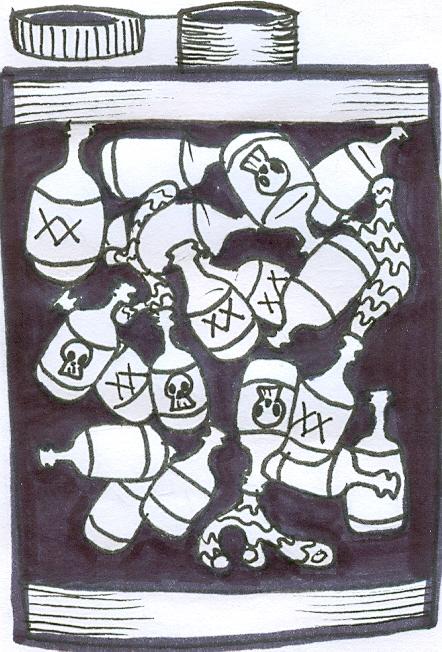Sobering Statistics
With prom a day away, alcohol-related incidents are a concern for student safety
There are billboards, commercials, and magazines advertising it. Whole departments of the grocery store are dedicated to it. Reality stars guzzle it with no abandon. Alcohol is everywhere and the temptation is high for students.
“Drinking is great,” senior Ashlee Davis* said. “It makes me feel awesome and loose. Besides, I only drink with friends. I’m just a social drinker.”
Drinking alcohol is illegal for anyone under the age of 21. Despite this, half of teenagers have had a drink by the age of 15 and it increases to more than 70 percent of teens by 18, according to the National Institute of Alcohol Abuse and Alcoholism.
“Drinking is horrible,” RRADD president Gabe Trevino said. “Most of it deals with peer pressure so much. I feel like even if you say it’s a one-time thing, it becomes more than a onetime thing.”
Prom season is prime time for drinking and safety concerns. Statistics show car-related accidents among teens drastically increase in the spring. A National Highway Traffic Safety Administration survey found that in 2005 the majority of teen car accidents involved alcohol during April, May and June—prom and graduation season. It found a total of 676 teens under the age of 21 were killed in alcohol-related accidents.
“The loss of life from drinking, it’s one that could be prevented by people making safe decisions and healthy choices,” RRADD sponsor Janet Howard said.
Schools do their best to create a safe environment at prom, but there is never a guarantee of an alcohol-free prom night, Lifeguard.com claims.
“Yeah, I’m gonna drink,” senior Jeff Shelby* said. “I’m doing it just to have fun. It’s to celebrate a good school year. It’s my last big thing as a senior so it should be great.”
In recent years, there have been incidents with district students being inebriated at prom. While each situation is handled on a case-by-case basis, students run the risk of legal and academic consequences—being arrested, receiving LEO and missing graduation.
“I think it’s a poor choice,” assistant principal Brandon Evans said. “Obviously, I can’t control the decisions that teens make. It’s their choice. Are we going to catch everyone? No. I’ve been doing this long enough to know that. It’s like speeding, you may not  always get caught, but when you do, you’ll have to deal with the ramifications.”
always get caught, but when you do, you’ll have to deal with the ramifications.”
The school will work with the Leander police department to keep prom safe. Four officers as well as 15 to 20 adult supervisors will attend prom to keep an eye out for suspicious behavior. There is also the possibility breathalyzers will be used in order to ensure a safe night. For some attendees, that’s enough to push their drinking plans back a few hours.
“I mean, yeah, I’m drinking,” senior Matt Scott* said. “But only after prom.”
While teens don’t drink as frequently as adults, when they do, they typically have at least five drinks per sitting, according to the National Institute of Alcohol Abuse and Alcoholism. The NIAAA classifies binge drinking for females as four or more drinks while for men it is five or more within a two-hour period.
“The unfortunate part in my years in administration is dealing with students dying because of alcohol abuse,” Evans said. “This is the prime time for negative decisions, since it’s the end of the year, but it’s also the prime time for people to use clear judgement skills. Don’t let one stupid thing ruin your whole life.”
Many scientists believe binge drinking at a young age can stunt brain growth and damage regular brain functions such as memory, coordination and motor skills. Binge drinking can lead to assault, rape, motor accidents, alcohol poisoning, and other serious problems including death, according to the non-profit helpguide.org.
A NHTSA 2006 study found 64 percent of drivers and motorcyclists between the ages of 15 and 20 were killed in an accident related to an alcohol content of .08 or higher.
“Drinking and driving is awful,” Trevino said. “You could die, you could kill someone, you could injure others, you could injure yourself. When you drink and drive, it’s not just you at risk.”
Twenty-four percent of teens say their parents never discussed the topic of drinking, alcoholism.about.com reports.
“All it takes is educating the youth and having a real talk about the cons physically, emotionally and financially,” RRADD sponsor Janet Howard said. “Communities need to be aware and have better experience with adolescent behaviors.”
According to helpguide.org, there are a few things parents and the community can do to prevent tragedy. First, parents can start the conversation by bringing up family history, making teens aware of alcohol problems that run in the family. They should discuss what alcoholism is and the dangers for people suffering with the illness. Secondly, parents need to set clear expectations and be aware of who their teen is hanging out with.
In the end, it will be up to the young adult to make the decision about drinking.
“You can’t prevent it,” Trevino said. “It’s something that not everybody is just going to stop doing. It takes time. We can reduce use, but it’s like smoking. You have to work towards the goal—stopping it—slowly. If you don’t drink, tell people about the risks, inform others to bring it to a stop.”
*Some names have been changed to protect the privacy of students.



